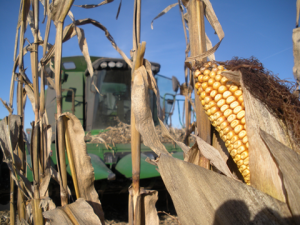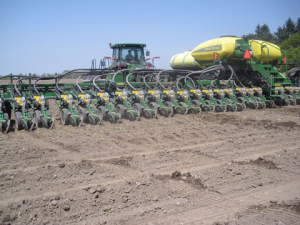Bill Cox, Department of Crop and Soil Sciences, Cornell University

Corn is by far the most important crop produced in the USA in both acreage and value. NY growers typically plant ~1,150,000 acres annually, making NY the 17th leading state in the USA in corn acres. NY is unique, however, in that planted corn acreage fluctuates between an approximate 50:50 ratio of grain corn and corn silage. Consequently, NY has historically been a leading corn silage producing state. Indeed, NY dairy producers planted approximately 500,000 acres in 2012 and 2013, making NY the 2nd leading state in the USA in corn silage acres. The NY Crop Reporting Service typically focuses on how NY agricultural commodities rank nationally so the importance of corn silage is highlighted but the importance of corn grain is often overlooked. This article will focus on the acreage and value of corn produced for grain and for silage over the last 25 years to emphasize the importance of both to the NY agricultural economy.
Total annual NY corn acreage averaged ~1,150,000 during the 1989-1993 and 1994-1998 time periods (Fig.1). Total NY corn acreage, however, dipped ~1% during the 1999-2003 and 2004-2008 time periods, averaging ~1,050,000 annually. The lower total corn acreage from 1999-2008 can be attributed mostly to the marked decline in corn grain acres during that 10-year period. Annual corn grain acreage averaged ~600,000 from 1989-1998 but dipped to ~510,000 from 1999-2008. The decrease in corn acres from 1994-1998 to 1999-2003 corresponded, as expected, with the decreased market price for grain corn (~$3.00/bushel to ~$2.55/bushel, respectively in NY).
Annual NY corn silage acreage, however, remained steady from 1989-2003 averaging ~540,000 during this period. In fact, annual corn silage acreage actually exceeded corn grain acres during the 1999-2003 period (~535,000 vs.495,000 acres, respectively). Milk prices remained similar during the 1994-1998 and 1999-2003 periods (~$14/ and ~$13.85/cwt, respectively), which probably contributed to stable corn silage acreage during this period. Annual corn grain acreage (~525,000), however, once again exceeded corn silage acreage (~480,000) during the 2004-2008 time period.

Corn grain prices rebounded during this period (~$3.50/bushel), especially in 2007, prompting more growers, even dairy producers, to plant corn for grain, which partially explains the ~10% decrease in annual NY corn silage acres during 2004-2008. The decrease in corn silage acres during the 2004-2008 period, however, is somewhat surprising because milk prices increased to $17/cwt during this 5-year period.
The annual value of corn silage produced in NY was consistently greater than that of grain corn from 1989 through 2008 (Fig.2). Annual corn silage value in NY showed a strong linear increase during this period, an average increased value of ~$20M during each 5-year period (~$185M during 1989-1993 to ~$260M during 2004-2008). In contrast, the annual value of grain corn in NY fluctuated during this 20-year period (an average value of ~$150M from 1989-1993, to ~$190M from 1994-1998, decreased to only $~130M from 1999-2003, but rebounded to ~$250M from 2004-2008).
The ratio of acreage and value of both crops, however, have changed dramatically in the last 5 years (Fig. 1 and 2). Annual corn grain acres increased greatly in NY (and in the USA) to an average of ~635,000 during 2009-2013. Obviously, the market price for corn (~$5.75/bushel) was the overwhelming factor in increased NY corn grain acreage during this period. The increase in acres and prices, coupled with relatively high yields, resulted in a dramatic increase in the annual grain corn value in this recent 5-year period (~$440M from 2009-2013). Corn silage acreage remained steady (~475,000) during the 2009-2013 period, despite the increase in average milk prices from ~$17 to ~$18.50/cwt. Nevertheless, the annual value of corn silage, driven by the increase in grain corn and subsequently corn silage prices, increased the annual value of corn silage to ~$375M during the most recent 5-year period.
Milk prices are close to record highs (but will probably fluctuate over the next 5 years); whereas corn prices are at their lowest since 2009. So it will be interesting to see how the ratio of corn silage to grain corn acreage will play out over the next 5 years in NY. In the meantime, let us celebrate the positive impact that grain corn has had on the NY agricultural economy in the last 5 years. Indeed, the average value of grain corn exceeded the average value of the entire fresh market vegetable industry or the total fruit industry from 2009-2013 (Fig.3).
Not only has the crop value increased dramatically, but the increased acreage and value has spurred new industries (ethanol and grain storage industries) and stimulated other upstate NY industries (trucking, increased sales of seed and other agricultural inputs, increased sales of agricultural equipment including the purchase of hundreds of new planters and corn combines, etc.). Obviously, the grain corn industry has had a tremendous, yet unacknowledged, value-added effect on the upstate NY economy. In conclusion, isn’t it time to report the value of our crops on a NY state basis instead of on a national basis? Instead of highlighting that NY is the 5th leading tart cherry state ($2.85M value), 4th leading pear state ($2.35M value), 8th leading strawberry state ($6.88M value), 4th leading sweet corn state ($68.4M), 4th leading fresh market snap bean state ($33.4M) but 21st corn grain state ($688M) in 2012, wouldn’t it be far more informative to say that NY grain corn was the 2nd leading agricultural commodity in NY in 2012?

